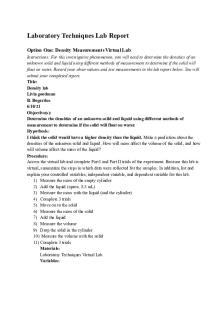Chem Lab report 1 - Introduction to Laboratory Techniques and Data Collection PDF

| Title | Chem Lab report 1 - Introduction to Laboratory Techniques and Data Collection |
|---|---|
| Course | (Uc) General Chemistry I Lab |
| Institution | Quinnipiac University |
| Pages | 5 |
| File Size | 94.5 KB |
| File Type | |
| Total Downloads | 89 |
| Total Views | 146 |
Summary
Introduction to Laboratory Techniques and Data Collection...
Description
Introduction to Laboratory Techniques and Data Collection
Purpose In this lab, the goal was to find the density of an unknown metal by using a pycnometer and a balance.
Procedure Can be found on page 25 in “General Chemistry CHE110L Laboratory Manual Fall 2019.”
Data Tables Carbon Copies of data have been attached to the back of this lab report. Calculations Carbon Copies of calculations have been attached to the back of this report. Mass of H2O: 26.197grams Density of H20: .99799g/mL Volume of H2O: 26.25mL Volume of Metal: 2.193mL Volume Initial of H2O: 26.25mL Volume of Metal: 2.193mL Mass of Metal: 18.269g Density of Metal: 8.330g/mL
Summary of Results: Temperature of Water (degrees Celsius Density of Water (g/mL) Volume of Pycnometer(mL) Unknown Metal # Density of Metal (g/mL)
21.0 Degrees Celsius .99799g/mL 26.25mL 6 8.33g/mL
Conclusion: The purpose of this lab was to use a pycnometer and a balance to find the density of a given unknown metal. The purpose of this lab was indeed achieved because the Density of the unknown metal was found to be 8.33g/mL. This conclusion was reached due to the finding of all the prerequisite measurements that had to be found in order to calculate the density of the metal. The temperature of the water was recorded as 21 degrees Celsius. The density of the water was found by diving the mass 26.197g by the volume of the water 26.25ml to get 0.997 g/ml. The density of the metal was calculated by diving the mass of the metal 18.269g by the volume of the metal 2.193ml to get 8.330g/ml. There were numerous sources of error that could be considered when finding the density of the unknown metal. One source of error could be if there was leftover water in the pycnometer, which would add to the overall mass of the pycnometer itself. Also, if the masses are not rounded to the correct significant figures, this could lead to alternations in the final density of the unknown metal. Another source of error is if there are bubbles in the pycnometer, this would lead to the mass of water being slightly off which would change the calculations slightly enough to be wrong. Next, if the thermometer is not calibrated correctly the temperature would be off, resulting in human error. Post Lab
1. Suppose you are instructed to measure the density of a different metal using a 50mL pycnometer. The mass of your pycnometer is 23.721g. After filling the pycnometer with water at 24 degrees Celsius, you find the mass of the pycnometer and water is 72.457g. The water is emptied out and the metal is placed in the pycnometer. The metal, by itself, is found to weigh 51.118g. The pycnometer with the metal in it is filled with water again and the pycnometer, water, and metal are found to weigh 115.442g. What is the density of the metal? 2. D=M/V 3. Density of water = .997296g/mL 4. Mass of Water = 72.457g – 23.721g = 48.736g 5. Volume of Water = Mass/ Density 6. 48.736g/ .997296g/mL = 48.8681 mL 7. Density of water = .997296g/mL 8. Mass of water = 115.442g – 72.457g = 42.985g 9. Volume of Water = 42.985g/.997296 = 43.10mL 10. Volume of Metal = 48.8681mL – 43.1mL= 5.7681mL 11. Mass of Metal = Mass of Pycnometer – Mass of Metal and Pycnometer 12. 51.118g – 23.721g= 27.397g 13. Density of Metal = 27.397g/ 5.7681mL = 4.749 g/mL
2. Suppose when taking the final mass measurement of the pycnometer, water, and metal, you forget to dry off the pycnometer and weigh it wet. How would this affect the value of the density of the metal ? Explain.
a. When weighing the final mass of the pycnometer, if the pycnometer is not dried off, then the density of the metal would be larger than it is supposed to be. The mass would be a larger value to be divided by the (constant) volume, in turn making the density larger....
Similar Free PDFs

Laboratory Techniques Lab Report
- 4 Pages

Lab 1 - Laboratory Techniques
- 14 Pages

Lab 1 - Laboratory Report
- 10 Pages

Chem Lab report 1 - Chem lab 1
- 4 Pages

Chem Lab Report 1
- 7 Pages

Chem lab report 1
- 12 Pages

CHEM 123L- Introduction LAB 1
- 2 Pages

Laboratory 11 - Lab Report
- 3 Pages
Popular Institutions
- Tinajero National High School - Annex
- Politeknik Caltex Riau
- Yokohama City University
- SGT University
- University of Al-Qadisiyah
- Divine Word College of Vigan
- Techniek College Rotterdam
- Universidade de Santiago
- Universiti Teknologi MARA Cawangan Johor Kampus Pasir Gudang
- Poltekkes Kemenkes Yogyakarta
- Baguio City National High School
- Colegio san marcos
- preparatoria uno
- Centro de Bachillerato Tecnológico Industrial y de Servicios No. 107
- Dalian Maritime University
- Quang Trung Secondary School
- Colegio Tecnológico en Informática
- Corporación Regional de Educación Superior
- Grupo CEDVA
- Dar Al Uloom University
- Centro de Estudios Preuniversitarios de la Universidad Nacional de Ingeniería
- 上智大学
- Aakash International School, Nuna Majara
- San Felipe Neri Catholic School
- Kang Chiao International School - New Taipei City
- Misamis Occidental National High School
- Institución Educativa Escuela Normal Juan Ladrilleros
- Kolehiyo ng Pantukan
- Batanes State College
- Instituto Continental
- Sekolah Menengah Kejuruan Kesehatan Kaltara (Tarakan)
- Colegio de La Inmaculada Concepcion - Cebu







